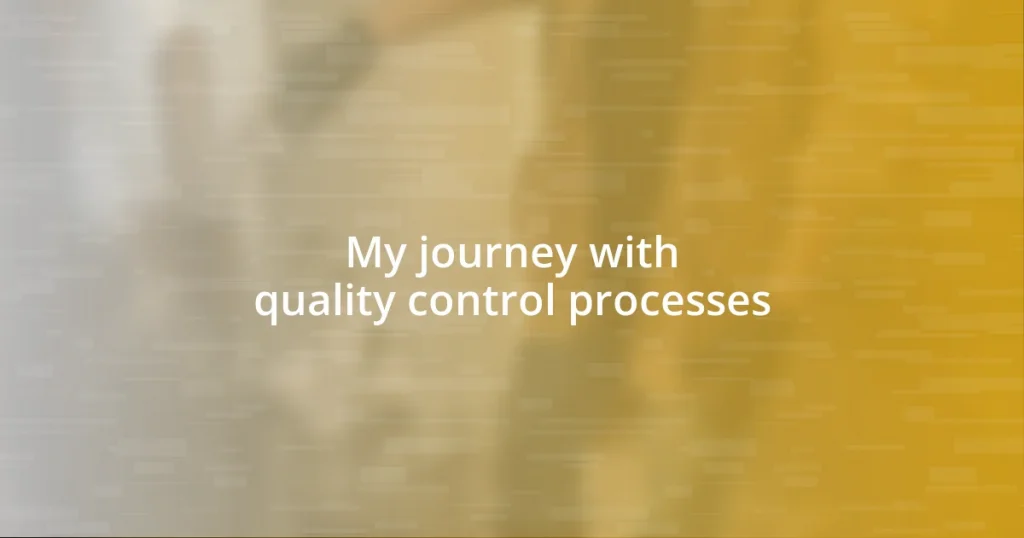Key takeaways:
- Quality control is crucial for maintaining product integrity and customer trust, highlighting the importance of early detection and continuous improvement.
- Effective techniques such as Statistical Process Control (SPC), regular audits, and open communication are vital for fostering a culture of quality within teams.
- The future of quality control will increasingly rely on technology, collaboration with suppliers, and a customer-centric approach to enhance product development and standards.

Understanding Quality Control Processes
Quality control processes are essential in ensuring that products meet specific standards and customer expectations. I remember an instance when I observed a significant defect in a batch during a routine inspection. It was a glaring reminder of how even small oversights can ripple through an entire production line, affecting not just quality, but also customer trust.
I’ve often wondered how quality control can be perceived as a tedious task, when in reality, it’s the backbone of any successful operation. In my experience, implementing systematic checks not only minimizes errors but also fosters a culture of excellence within a team. There’s something deeply satisfying about catching potential issues before they reach the customer; it feels like a small victory that boosts morale and collaborative spirit among colleagues.
Understanding quality control processes means recognizing that they are not just about ticking boxes. They require a commitment to continuous improvement and adaptation. For example, I’ve found that engaging the team in discussions about quality metrics often leads to innovative solutions, revealing that everyone has a stake in achieving high standards. Doesn’t it feel empowering to know that quality is a shared responsibility?

Importance of Quality Control
Quality control stands as a guardian of product integrity, and I can personally attest to its vital role. One time, I oversaw a project where a minor flaw nearly went unnoticed. Thankfully, our quality control protocols caught it just in time, saving us from potential customer complaints and loss of reputation. That experience reinforced my belief that effective quality control is not just about compliance—it’s about protecting the brand and the trust we’ve built with our customers.
The significance of quality control can be illustrated through a few key points:
- Customer Satisfaction: Meeting quality standards consistently leads to happier customers who are more likely to return.
- Cost Efficiency: Early detection of issues reduces waste and lowers the costs associated with rework.
- Continuous Improvement: Quality control encourages teams to strive for excellence, fostering innovation and a proactive mindset.
- Risk Mitigation: By identifying potential problems early, we minimize the risk of product recalls and legal issues.
In my view, quality control is like a safety net—one that ensures we’re always on track to deliver our best.

Techniques for Effective Quality Control
Effective quality control techniques are the backbone of any successful process. One technique I rely on is the use of statistical process control (SPC), which allows me to monitor and control production processes using data analysis. I vividly recall a project where we discovered that minor fluctuations in our production line led to inconsistencies in product quality. By applying SPC, we not only identified the root cause but also significantly reduced defects, which felt like reclaiming control of our craft.
Another method I swear by is implementing regular audits and reviews. I remember conducting quarterly audits and finding not only minor errors but also surprising insights into team performance and process efficiency. These audits initiate thoughtful conversations that can drive improvements and foster accountability within the team, enhancing the overall quality culture. They challenge us to find the balance between adherence to procedures and encouragement for innovative thinking.
Lastly, fostering an environment of open communication allows for feedback loops that can reveal unnoticed issues. I often encourage team members to voice concerns or suggestions about processes, and this approach has led to some game-changing improvements. There’s something powerful about collaboration in quality control that brings everyone together with a shared goal, turning what could be a mundane task into a vibrant, team-driven initiative.
| Technique | Description |
|---|---|
| Statistical Process Control (SPC) | A data-driven approach that helps monitor production processes to maintain consistent quality. |
| Regular Audits | Scheduled reviews that assess processes and performance, promoting accountability and continuous improvement. |
| Open Communication | Encouraging team dialogue to share insights and concerns for ongoing quality enhancement. |

Challenges Faced in Quality Control
Quality control comes with its own set of challenges, each one informing my approach to improvement. One challenge I often faced was the variability in team adherence to quality standards. There were times when team members, under pressure to meet deadlines, overlooked crucial quality checks. I vividly recall an instance where one overlooked step not only delayed production but also required significant rework. This taught me the importance of fostering a culture where quality isn’t just a checklist, but a shared value everyone upholds, even amid crunch times.
Another hurdle is managing the evolving nature of customer expectations. I remember receiving feedback that our products didn’t meet new durability standards that customers had come to expect. This shift left me pondering: how could we adapt without compromising our processes? It pushed me into action, leading to the implementation of more flexible quality measurement techniques. We began involving customer feedback in our quality assurance measures, which provided a fresh perspective and allowed us to evolve alongside market demands.
Lastly, the challenge of resource allocation often looms large. Balancing the demand for quality control with the need for efficiency can feel like walking a tightrope. During one project, I had to decide how much time and resources to dedicate to quality checks without derailing the project timeline. By prioritizing critical quality checkpoints, I learned that sometimes less is more—a focused approach can yield better results than exhaustive checks that demoralize the team. These moments, though tough, sharpened my ability to navigate quality control with agility and foresight.

Lessons Learned from Quality Control
Quality control has taught me that precision is vital, but flexibility is equally important. I once managed a project where a minor adjustment to our process generated unexpected results. It made me realize that while protocols are essential, being adaptable when anomalies occur can lead to insights that rigid adherence might overlook. Have you ever felt that thrill of discovering a new way to improve an approach just by being open to change?
One significant lesson I took from my quality control journey is the profound impact of team morale on the quality of work produced. For instance, during a particularly stressful quarter, I noticed a drop in product quality coinciding with team burnout. This prompted me to refocus my energy on team wellness, fostering a supportive environment. It struck me then how crucial it is to recognize that investing in your team translates into better quality outputs. Doesn’t it feel rewarding to watch the team excel when they feel valued?
Moreover, I’ve learned that customer feedback is not just about meeting expectations; it’s about exceeding them. I distinctly remember reviewing customer feedback on a product that I felt confident about, only to discover it didn’t resonate with users as I anticipated. This experience redefined my perspective: I realized quality control isn’t solely about the internal processes but also about understanding and learning from the end-user experience. Isn’t it fascinating how our greatest lessons sometimes come from unexpected places?

Future of Quality Control Practices
Looking ahead, I believe the integration of technology will redefine quality control practices. For instance, I’ve seen how data analytics can spot patterns in production errors that might not be visible through traditional methods. Imagine the potential of machine learning algorithms predicting quality issues before they occur—how much time and resources could that save? That prospect is not just exciting; it’s transformative.
As I envision the future, the role of collaboration stands out prominently. In a recent project, collaborating closely with our suppliers led to significant improvements in product quality. It made me realize that sharing responsibility for quality extends beyond internal teams; fostering strong partnerships can lead to shared insights and innovations. How often do we think about our supply chains when assessing quality?
Furthermore, I anticipate a shift towards a more customer-centric approach in quality control. Engaging customers in the quality conversation has the potential to reshape everything from product development to the final checks. I remember a moment when customer input directly influenced our redesign process, resulting in a product that not only met standards but delighted users. Isn’t that the ultimate goal? The future, it seems, holds the promise of a quality control landscape where customers play a vital role, making our processes not just reactive but proactively aligned with their needs.















